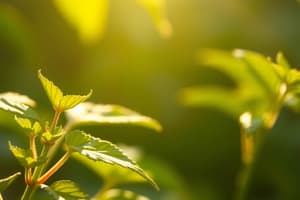Podcast
Questions and Answers
What is the main purpose of photosynthesis?
What is the main purpose of photosynthesis?
- To convert glucose into energy.
- To absorb carbon dioxide from the atmosphere.
- To release oxygen for respiration.
- To capture light energy to produce food. (correct)
Which of the following reactions occurs during the light-dependent stage of photosynthesis?
Which of the following reactions occurs during the light-dependent stage of photosynthesis?
- Carbon Dioxide Fixation
- Glucose Formation
- Splitting of water (correct)
- Conversion of ATP to ADP
What enzyme is responsible for attaching carbon dioxide to ribulose 1,5-biphosphate (RuBP)?
What enzyme is responsible for attaching carbon dioxide to ribulose 1,5-biphosphate (RuBP)?
- NADPH reductase
- Phosphofructokinase
- RuBisCo (correct)
- ATP synthase
In which stage of photosynthesis is ATP produced?
In which stage of photosynthesis is ATP produced?
What is the final product formed from two PGAL molecules during the light-independent reactions?
What is the final product formed from two PGAL molecules during the light-independent reactions?
What does the light-independent reaction primarily convert?
What does the light-independent reaction primarily convert?
What happens to the 6-carbon molecule produced during carbon dioxide reduction?
What happens to the 6-carbon molecule produced during carbon dioxide reduction?
Which of the following best describes the light-independent reactions?
Which of the following best describes the light-independent reactions?
Flashcards
Photosynthesis
Photosynthesis
The process where plants capture light energy to make food.
Light-dependent reactions
Light-dependent reactions
Photosynthesis step needing light to convert light to chemical energy (ATP).
Light-independent reactions
Light-independent reactions
Photosynthesis step that doesn't need light to use ATP to make sugars.
ATP
ATP
Signup and view all the flashcards
Sugar (glucose)
Sugar (glucose)
Signup and view all the flashcards
Carbon Dioxide Fixation
Carbon Dioxide Fixation
Signup and view all the flashcards
Carbon Dioxide Reduction
Carbon Dioxide Reduction
Signup and view all the flashcards
Calvin Cycle
Calvin Cycle
Signup and view all the flashcards
Study Notes
Photosynthesis
- Photosynthesis is the process of capturing light energy to create food.
- Plants, algae, and other chlorophyll-bearing organisms capture light energy and use it to produce energy-rich organic molecules from carbon dioxide.
- The overall reaction for photosynthesis is: 6CO2 + 6H2O → C6H12O6 + 6O2 (carbon dioxide + water → glucose + oxygen)
- Photosynthesis involves two sets of reactions: light-dependent and light-independent reactions.
Light-Dependent Reactions
- These reactions only occur in the presence of light.
- They capture solar energy and store it in molecules that will provide the energy for the next reactions.
- Key steps are:
- Converting light energy into electron energy
- Splitting water molecules
- Converting electron energy into chemical energy in ATP.
Light-Independent Reactions (Calvin Cycle)
-
These reactions do not directly require light.
-
They convert short-term energy storage (ATP) to long-term energy storage (sugar).
-
Key Steps:
- Carbon Dioxide Fixation: Carbon dioxide enters the leaf, and an enzyme combines it to RuBP (a 5-carbon compound).
- Carbon Dioxide Reduction: The 6-carbon molecule splits into two 3-carbon molecules (PGA). PGA is reduced to a three-carbon molecule called PGAL in a series of reactions (using ATP and NADPH).
- Glucose Formation: PGAL molecules rearrange to form a six-carbon sugar (glucose).
-
The Calvin Cycle is vital to converting inorganic carbon into organic molecules.
Chloroplast Structure and Function
- Chloroplasts are the organelles where photosynthesis takes place.
- They have a double membrane.
- The chloroplast contains grana (stacks of thylakoids) and stroma (fluid surrounding the grana).
- Thylakoid membranes are where the light-dependent reactions occur.
- Stroma is the site for the light-independent reactions (Calvin cycle).
Respiration
- Respiration is the process of making energy available in the cell.
- Respiration involves breaking down complicated molecules (like glucose) into simpler molecules (like CO2 and water).
- The essential reaction for respiration is: C6H12O6 + 6O2 → 6CO2 + 6H2O + 36 ATP (glucose + oxygen → carbon dioxide + water + energy).
- Respiration occurs mainly in mitochondria and the cytoplasm.
- Cellular respiration has three main stages: Glycolysis, Krebs Cycle and the Electron transport system.
Glycolysis
- Occurs in the cytosol.
- Glucose is split into two molecules of pyruvate.
- Produces a net gain of 2 ATP.
Krebs Cycle
- Takes place in the mitochondrial matrix.
- Harvests energy from the glucose molecule by producing ATP.
- Produces a net gain of 2 ATP.
Electron Transport System
- Occurs in the inner mitochondrial membrane.
- Generates a substantial amount of ATP.
- Produces a net gain of 32 ATP.
- Total ATP production from one glucose molecule is around 36.
Summary
- Photosynthesis uses light energy to convert carbon dioxide and water into glucose and oxygen.
- Respiration converts glucose and oxygen into carbon dioxide, water, and energy in the form of ATP. Both processes are crucial for the survival of most life forms.
Studying That Suits You
Use AI to generate personalized quizzes and flashcards to suit your learning preferences.




